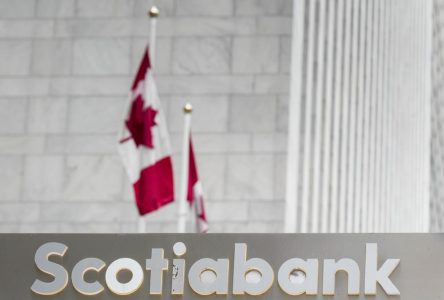TORONTO — Scotiabank will focus its growth efforts closer to home and could exit some foreign markets under a new strategic plan outlined by chief executive Scott Thomson on Wednesday.
The five-year plan is the result of a review Thomson launched after coming on as CEO in February, as he looks to turn around Scotiabank’s years of underperformance relative to peers on shareholder returns, revenue growth and other key metrics.
The strategy shift will see the bank focus less on outright growth and more on profit margins, said Thomson.
“It’s a fundamentally different philosophy on how to create value for shareholders.”
The change in focus has the bank pushing more funding to stable, lower-risk countries, directing about 90 per cent of incremental capital to its Canadian, U.S. and Mexico markets, while spending in its Latin American markets will face increased scrutiny.
“This is a meaningful shift in how we allocate capital,” Thomson said during a media roundtable.
Canada is the priority on spending, where the bank hopes to sell customers on more products as part of a push to increase margins and boost its number of “primary relationships,” where customers have an active chequing account plus a payment or investment product.
The previous strategy has left the bank with only 16 per cent of retail clients in that primary category.
To win clients away from other big banks, Scotiabank plans 50 per cent more investment in its Canadian banking unit through to the end of the plan.
It will also lean more on its online-based Tangerine bank, focus more on newcomers, and push advisors to increase sales volumes by 25 to 30 per cent.
While the bank is focused on domestic growth, it is also aiming to reduce its Canadian real estate footprint by 10 to 15 per cent by 2028, as Thomson said the bank lags its peers on deposits and clients per branch.
The bank is already working on the efforts, taking an $87-million charge in the last quarter on real estate, and confirming a number of branch closures coming in the Maritimes. It’s also part of a longer-term trend, with the bank reporting 194 fewer branches and offices at last quarter end than it did two years ago.
Scotiabank is also pushing for efficiencies across its operations. It announced last quarter it was cutting about three per cent of its workforce and took a $354-million charge related to the move.
In its International Banking segment, it expects efficiency programs to account for 60 per cent of earnings growth throughout the plan.
The bank will also be selective on funding to its Chile and Peru personal and commercial businesses, while its Colombia and Central America divisions, including Costa Rica and Panama, are expected to turn around without more funding or the bank will look to exit the markets.
“They’ve got a plan, they’re executing on that plan, but we will determine whether to continue on that plan or redeploy capital in relatively short order,” said Thomson.
The potential pullback on less profitable markets is part of a longer-term trend at the bank, which has already left 25 higher-risk regions over the past decade.
“The return profile of the international bank has not been commensurate with the risk, and it’s been a drag on overall returns,” said Thomson.
Scotiabank will put more effort into growing organically in the U.S., while leaving open the potential for future acquisitions, as well as growth in Mexico and the Caribbean.
Thomson said that with no other Canadian bank in Mexico, and no U.S. bank in Canada, Scotiabank is well positioned to take advantage of the full free trade region.
“The North American corridor, there’s a megatrend behind that right now, you see the amount of capital going into Mexico” he said, noting that pipeline and rail companies are also focused on connecting the three markets.
As the bank looks to turn its fortunes around, in part through boosting worker productivity, Thomson said he was committed to creating a psychologically safe environment, and setting cultural behaviour from the top.
“How we execute will be an essential ingredient in allowing us to achieve our objective of profitable, sustainable growth.”
The months-long strategic review didn’t, however, yield any shift in the bank’s sustainability efforts, he said.
The bank has faced criticism for being the second-largest fossil fuel funder in Canada, and among the top 10 globally, financing $182 billion between 2016 and 2022, according to the Banking on Climate Chaos report.
It has also faced protests recently for investments in Israeli defence contractor Elbit Systems by its 1832 Asset Management division, which led to heightened security at the investor day.
Thomson said that while the bank didn’t shift ESG (environmental, social and governance) practices from the review, he’s pleased with the bank’s sustainability track record that saw it recognized on Monday as among the top four per cent of banks globally in the 2023 S&P Global Corporate Sustainability Assessment.
“I couldn’t be more pleased to be running a bank where we’re taking this climate change accountability seriously.”
This report by The Canadian Press was first published Dec. 13, 2023.
Companies in this story: (TSX:BNS)



